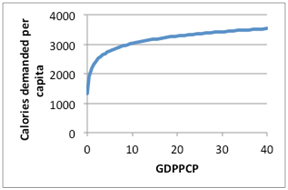International Futures Help System
Total Calorie Demand (and the Share from Meat)
In the first year of the model, a predicted level of calories per capita (CalPerCap) is estimated as an increasing function of average income. [1] This is bound from above by an assumed maximum value, given by the global parameter calmax .

The predicted per capita value is converted to total calorie demand (caldem) by multiplying by the population (POP). A multiplicative shift factor (calactpredrat), used in the forecast years, is then calculated by dividing by the value of calories available (CLAVAL) by this demand.
![]()
where
CLAVAL is calorie availability; its calculation is described below in the section on calorie availability
This value of calactpredrat gradually converges to 1 over a period given by the global parameter agconv and appears in future equations with the name adjustforinitialdevc.
In the forecast years, a predicted value of per capita calorie demand (CalPerCap) is once again calculated as a function of average income using the equation above, with a maximum value given by calmax . A base level of calories per capita (calbase) is also calculated, which is given as the minimum of 3000 or calmax minus 300. Because comparative cross sections show a growth of around 4 calories per capita per year independent of average income, a factor representing this increase (caldgr) is calculated as:

Thus, depending on the exact values of calmax , calbase, and CalPerCap, caldgr grows each year by a value that centers around 4 calories. This value is then added to the predicted value in calculating the total demand for calories. The equation also takes into account calmax and the multiplicative shift factor on calories per capita noted above.
![]()
This total calorie demand is divided into demand from meat and demand from crops. Meat demand in tons (AGDEM, category 2) is discussed in the following section. Here we focus on how this is converted to calories. Two country-specific parameters, lvcfr and sclavf, calculated in the first year of the model are key to this conversion.
lvcfr is a country-specific factor converting livestock in tons to calories. This is initially set equal to the global parameter lvcf , but may be adjusted downward. This is done in cases where the initial estimate of the share of calories from meat exceeds a maximum value: given by t, i.e., if

where
calmeatm is a global parameter indicating the maximum share of calories to come from meat
In this case, lvcfr is repeated reduced by 10 percent until the share of total calories coming from meat falls below calmeatm .
sclavf is a country-specific multiplicative shift factor that converts the total annual demand for food crops and crop equivalents from meat to daily calorie availability

Note that sclavf can take on a value greater that or less than 1.
lvcfr and sclavf maintain the same value in all the forecast years.
 International Futures at the Pardee Center
International Futures at the Pardee Center